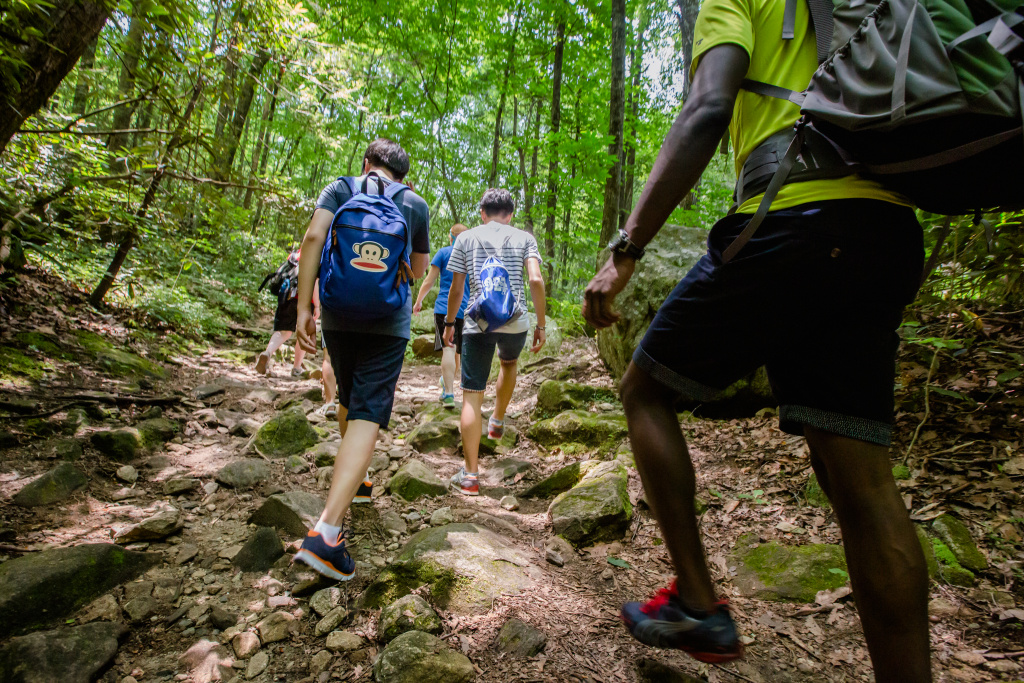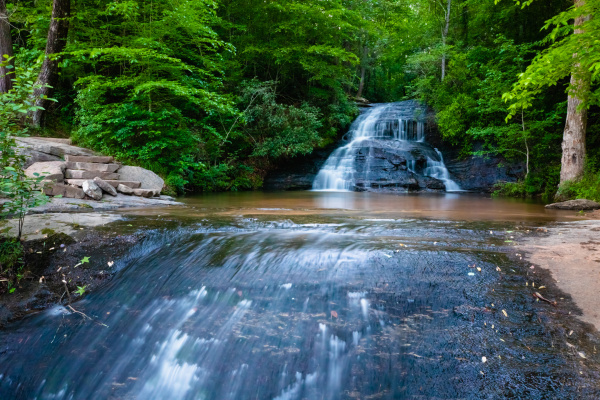Check the state park’s website before visiting for hours and number of cars allowed. Due to the COVID-19 pandemic, many are operating under limited hours and capacity. Other rules and regulations in effect are posted as well.
State parks have been around since Niagara Falls was named such in 1885. However, a boom occurred in the 1930s under U.S. President Franklin D. Roosevelt’s New Deal. The legislation established the Civilian Conservation Corps, which employed young men to work on environmental conservation projects. The result was hundreds of state parks across the country, including 16 in South Carolina.
Paris Mountain
About 5 miles from BJU
Website: southcarolinaparks.com/paris-mountain
- Hiking
- Biking (Sunday through Friday only)
- Camping
- Picnicking
- Fishing
- Swimming
- Boating
Paris Mountain State Park has much to offer on its 1,540 acres and is a hop and a skip away from the BJU campus. As one of the 16 state parks the Civilian Conservation Corps built during the Great Depression, the park boasts a historical bathhouse as its Park Center and is on the National Register of Historic Places.
With 15 miles of hiking and biking trails, Paris Mountain is a local favorite for outdoor adventure. This is one reason park rangers have asked that no mountain bikes take to the trails on Saturdays.
Perhaps the most unique detail about this state park is that Paris Mountain is a monadnock, a mountain that rises out of flat land. Though the Blue Ridge Mountains aren’t far away, the land surrounding Paris Mountain — referred to as the piedmont — is a plateau between the mountains and the coastal plain. Monadnocks are formed when surrounding landmass erodes away and more resistant rock is left behind. Another famous monadnock is Stone Mountain in Georgia.
Jones Gap
About 26 miles from BJU
Website: southcarolinaparks.com/jones-gap
- Hiking
- Fishing
- Camping
As it flows through Jones Gap State Park’s 13,000 acres, fishermen and hikers both take advantage of South Carolina’s first designated scenic river, the Middle Saluda River. The abundant fishing makes this S.C. state park the perfect place for a hatchery and a hands-on ecology learning center, complete with a living lab.
Jones Gap State Park and Caesars Head State Park link to form the Mountain Bridge Wilderness Area. Hiking trails that begin in Jones Gap end on trails in Caesars Head. Dedicated adventurers can tromp across the mountains and spend the night in wilderness campsites.
Two of the trails in Jones Gap lead to waterfalls. Rainbow Falls — not to be confused with the Rainbow Falls in Gorges State Park in North Carolina — is a 100-foot free-falling waterfall with smaller cascades below. The sight is sufficient reward for the grueling hike, but if you want an easier trek, Jones Gap Falls — a 50-foot fall — is a moderate hike.
Caesars Head
About 32 miles from BJU
Website: southcarolinaparks.com/caesars-head
- Hiking
- Wilderness camping
If you enjoy driving curvy mountain roads, you will enjoy the drive to Caesars Head State Park. It’s only a short walk from the Visitors Center to the overlook and the sweeping view of the Mountain Bridge Wilderness Area. At 3,208 feet above sea level, you can even see Greenville in the distance.
Don’t miss the opportunity to visit Devil’s Kitchen which is just off to the side. Native American legend says that the devil created the narrow crevice by pouring hot liquid over the rock and cracking it. Or water froze between the granite gneiss layers and broke the rock apart. Take your pick.
Another distinguishing feature of Caesars Head State Park is that it is home to the tallest waterfall in South Carolina. Just up Highway 276 from the Caesars Head Overlook, follow the Raven Cliff Falls trail to view the 420-foot Raven Cliff Falls. If you’re up for more of a challenge, take the 6.6-mile trail to the suspension bridge over the river just above the Falls.
Table Rock
About 28 miles from BJU
Website: southcarolinaparks.com/table-rock
- Hiking
- Camping
- Swimming
- Picnicking
As previously mentioned, Paris Mountain State Park is listed as a historical landmark, but it is not the only state park to be so. Table Rock State Park has many cabins that were built by the Civil Conservation Corps and that are also listed on the National Register of Historic Places. Included on that list is the lodge which boasts a beautiful view of the mountains from its terrace.
In keeping with its historicity, this S.C. state park features a bona fide swimming hole. It also has two lakes where visitors can rent boats — either for fun or for fishing — and two mountains that visitors can hike and climb.
Table Rock State Park is also the eastern end of the 77-mile long Foothills Trail. Construction on the trail began in 1968 as an effort to conserve the Appalachian foothills and to increase their accessibility. The trail ends in Oconee State Park, Georgia, and has had many spur trails added through the years — including one up to Caesars Head State Park.
Croft
About 39 miles from BJU
Website: southcarolinaparks.com/croft
- Hiking
- Biking
- Playground
- Picnicking
- Camping
- Fishing
- Boating
- Horseback riding
The 7,054 acres of Croft State Park were formerly a World War II U.S. Army infantry training base. The camp housed 250,000 soldiers and shut down in 1947 after the war. The land became a state park in 1949, but training foxholes are still visible in the park today.
Croft is set apart by its equestrian facilities. It has several horse trails, two considered strenuous. And once every month — excluding December and January — horses and riders perform in the show ring.
Croft State Park is also home to the Advance America Bridge, a 65-foot expansion bridge and the longest footbridge in the S.C. state park system. The Advance America Bridge is part of the Palmetto Trail which spans South Carolina from coast to mountains. The trail is 500 miles long and includes sidewalks, greenways, rails-to-trails (such as Greenville’s beloved Swamp Rabbit Trail) and the steps of the state capitol, but nothing motorized. On the Palmetto Trail, it is possible to hike from Columbia to Walhalla.








